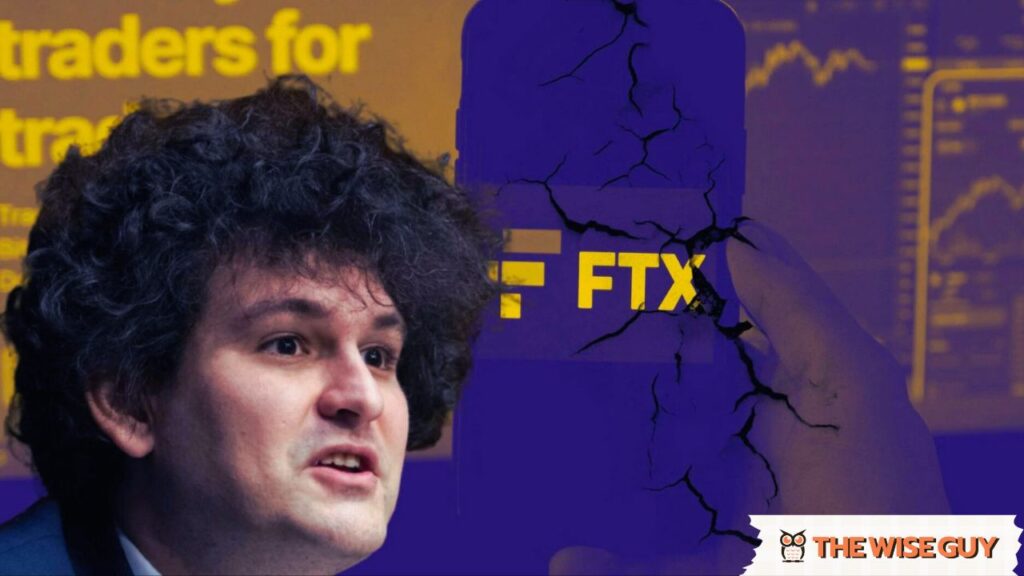???? GM,
Grab your favorite beverage (even if it’s a little early, we won’t tell), and get ready for the juiciest headlines that have been lighting up the Internet this week! ????
1️⃣ The Intricacies Behind Jaynti Kanani’s Departure and the Future of Polygon 2.0
2️⃣ Dogecoin NFT Community ‘Own The Doge’ Is Installing Kabosu Dog’s Statue in Japan
3️⃣ Sam Bankman-Fried’s bean bag chair is a liar too
4️⃣ Editor’s Wrap: Weren’t We All Were Charmed By SBF At Some Point

The Intricacies Behind Jaynti Kanani’s Departure and the Future of Polygon 2.0

In a surprising turn of events, Jaynti Kanani, co-founder of Polygon, announced his departure from daily operations on the blockchain scaling project.
This development has raised concerns about the future of Polygon, particularly given that Kanani is the third high-profile executive to leave the company this year.
Delving deeper into the story, we uncover a narrative that sheds light on the dynamics within the project and the path that led to Kanani’s exit. Drawing on industry sources and insider information, this article pieces together the untold story of Jaynti Kanani’s departure, revealing the intricacies hidden beneath the surface.
The Early Days of Polygon
To understand the events that led to Kanani’s exit, we need to revisit the genesis of Polygon. Originally known as MATIC, Polygon was conceived by Kanani, alongside Anurag Arjun, after their departure from housing.com. Together, they formed layer-2 MATIC, a team comprising a coder, a product specialist, and a desire to captivate audiences with their blockchain solution. It was during this time that Sandeep Nailwal entered the picture.
The Rise of Polygon and Sandeep Nailwal’s Role
As Binance expanded its presence in India, Polygon garnered attention. With their project gaining exponential traction, they attracted a market cap of $400 million after being enlisted on Binance. While Anurag and Jaynti toiled away in the background, it was Sandeep Nailwal who emerged as the face of Polygon. His ability to connect with audiences and market the product propelled Polygon’s visibility. However, it became apparent that Sandeep’s involvement was primarily on the marketing, lacking technical expertise.
The Shift in Dynamics
Did a subtle shift in dynamics occur within the Polygon team as Sandeep’s prominent role overshadowed Anurag and Jaynti, who were integral to the project’s development? Were there concerns about Sandeep being positioned as the poster boy for the Indian web3 ecosystem, and did this inadvertently sideline Anurag and Jaynti? All these questions are being raised.
The team wanted to shift the narrative, expand their offerings, and build bridges and modules to establish Polygon as a scalable solution. While Sandeep’s marketing acumen brought considerable exposure, questions arose regarding his positioning as the poster boy for the Indian web3 ecosystem. Undoubtedly, Sandeep would have made significant profits through advisory roles and investments, creating a nexus of influence and funding.
The Rift and Sandeep’s Ascendancy
The question also is that did an alleged rift start to emerge within the team as Sandeep assumed control of various aspects, leading to tensions caused by valuation decisions and a growing reliance on Sandeep’s marketing prowess?
Valuation decisions and a growing reliance on Sandeep’s marketing prowess created tensions. The focus seemed to be directed solely towards promoting Sandeep’s persona, inadvertently sidelining Anurag and Jaynti.
The Mystery of Jaynti Kanani’s Departure
On Tuesday, Kanani publicly disclosed his departure, explaining that he had ceased daily operations on Polygon six months prior to pursue new adventures. While expressing confidence in Polygon’s future and enthusiasm for the upcoming Polygon 2.0, questions linger regarding the suddenness of his exit. Given Polygon’s pioneering status and prominent position in the industry, the circumstances around Kanani’s departure warrant closer examination.
The Impact of Kanani’s Exit
Kanani’s departure undoubtedly raises concerns among industry insiders, creating uncertainties about Polygon’s future direction. However, it is important to remember that Polygon has proven its resilience and flexibility throughout its journey, and this setback may offer an opportunity for new talent to emerge and contribute to the project’s continued success.
As we navigate the intricate landscape of Jaynti Kanani’s departure from Polygon, it becomes clear that the factors underlying his exit involve a complex interplay of personalities, divergent visions, and shifting dynamics within the project. While the departure of a co-founder is undoubtedly a significant event, Polygon’s journey and future prospects remain compelling. As the industry awaits the unveiling of Polygon 2.0 and anticipates the subsequent chapters in this unfolding story, the true impact of Kanani’s exit will become clearer.
High-level departures in the crypto industry, like Kanani’s, can often signify trouble.
Polygon is a layer-2 scaling solution for Ethereum, designed to deliver cheaper, faster, and more private transactions. Despite its ongoing executive reshuffling, Polygon still holds the thirteenth-largest cryptocurrency by market cap, valued at $5.2 billion according to CoinGecko.
This series of departures comes amid a challenging period for Polygon, with its governance token, MATIC, falling 80% since its all-time high in December 2021.
Despite the departure of Kanani, Polygon is planning to transition to Polygon 2.0, a network of interconnected layer-2 chains powered by zero-knowledge technology. This upgrade will transform the current MATIC token into POL.
Disclaimer: The opinions expressed in this article are solely those of the author who is an industry source and do not reflect the views or opinions of CoinWestern.

Dogecoin NFT Community ‘Own The Doge’ Is Installing Kabosu Dog’s Statue in Japan

Greetings Doge lovers! In an exciting and paw-some development, the passionate NFT community behind the iconic ‘doge’ meme is teaming up with local governments to bring a physical statue of Kabosu, the adorable Shiba Inu who inspired the meme, to Sakura, Japan. ????
Mark your calendars for November 2, as that’s the day Kabosu’s statue will be unveiled in Sakura Furusato Square, coinciding with her birthday. The community, known as PleasrDAO, has been buzzing with anticipation, collaborating closely with the City of Sakura to make this heartfelt tribute a reality.
But that’s not all! These dedicated Doge enthusiasts have even set their sights on the moon, dreaming of one day placing Kabosu’s statue there. ???? Yes, you heard it right! The moon might just become a canine haven thanks to the incredible Doge community.
Speaking of the community, PleasrDAO aims to be the ultimate online gathering place for Doge and meme enthusiasts. Their journey has taken them to Hollywood, electronic dance music bangers, and even outer space, with a Doge NFT set for a SpaceX mission to the moon. ????
To celebrate the statue unveiling, PleasrDAO has a host of interactive events and surprises in store. Not only will attendees get the chance to meet Kabosu and her human, but they’ll also receive special privileges based on their NFT holdings. ????
It’s worth mentioning that PleasrDAO doesn’t just collect NFTs and celebrate Doge; they also give back to meaningful causes worldwide. Through their initiative called Own The Doge, they have become the top crypto contributor to Save The Children, exemplifying their belief in the mantra “Do Only Good Everyday,” abbreviated as DOGE. ????
In addition to their philanthropic efforts, Own The Doge is working on an exciting doge documentary, chronicling Kabosu’s life and the meteoric rise of the meme. It’s sure to be a tail-wagging success!
The history of the doge meme itself is quite remarkable. It all began in 2010 when Atsuko Sato captured an adorable snapshot of Kabosu for her blog. Little did she know that this picture would go viral when a Reddit user, John Monarch, labeled it as “doge.” ????
Since then, this lovable Shiba Inu and her meme have become an integral part of internet culture. The popularity of doge even led to the creation of the famous Dogecoin in 2013, as well as numerous other dog-themed tokens. At their peak, these tokens commanded a market capitalization of billions of dollars! ????
Sam Bankman-Fried’s bean bag chair was a lie too?

The trial of Sam Bankman-Fried, the founder of FTX, continues to captivate audiences as witnesses take the stand and shed light on the alleged fraudulent activities of the cryptocurrency exchange. Testimony from Bankman-Fried’s former college roommates, Adam Yedidia and Gary Wang, has provided compelling evidence against the defendant.
In yesterday’s proceedings, Marc-Antoine Julliard, a commodities trader and FTX customer, revealed that he did not withdraw his funds from the exchange despite its financial troubles.
This decision was influenced by Bankman-Fried’s reassuring tweets claiming that “FTX is fine. Assets are fine.” Julliard stated that he believed Alameda Research, Bankman-Fried’s company, would cover any losses. This testimony highlights the impact of Bankman-Fried’s public statements on investor behavior.
Yedidia, who worked for Bankman-Fried at both Alameda Research and FTX, testified that the defendant was aware of the company’s dire situation as early as late June or early July 2022. This conversation took place on a padel tennis court in their luxurious Bahamas complex. Yedidia, immunized against prosecution, provided a detailed account of Bankman-Fried’s knowledge and behavior leading up to the collapse of FTX.
Notably, Yedidia’s code writing for FTX inadvertently exposed the extent of Alameda’s liabilities. A bug in the code exaggerated Alameda’s debts, catching the attention of the company in December 2021. Yedidia resolved the bug in June 2022, revealing that Alameda was still $8 billion in debt. This discovery raised significant concerns for Yedidia, prompting him to question Bankman-Fried about the company’s financial situation during their conversation on the padel tennis court.
Throughout the trial, evidence has emerged that Bankman-Fried granted special privileges to Alameda Research, allowing the company to withdraw unlimited funds from FTX, including customer deposits. These privileges, not disclosed to the public, constituted a breach of trust with FTX customers.
In addition to Yedidia’s testimony, Matt Huang, a co-founder of Paradigm, a venture capital firm, provided insight into the investment made by his company into FTX. Huang expressed concerns about FTX’s governance and its relationship with Alameda. If it was discovered that Alameda received preferential treatment, it could have led customers to seek alternative trading platforms.
The prosecution appears to be building a strong case against Bankman-Fried, and the defense faces an uphill battle. With more witnesses expected to testify, including other investors and customers, the trial is likely to unveil further evidence of the alleged fraudulent activities committed by Bankman-Fried and his associates.
Editor’s Wrap: Weren’t We All Were Charmed By SBF At Some Point

The advent of blockchain technology and digital assets presents a tremendous opportunity for global economic transformation, providing access to financial services for the unbanked and driving innovation.
However, regulators like SEC Chairman Gary Gensler seem determined to stifle the growth of these technologies with misguided and excessive regulations that fail to grasp their full potential. Fortunately, recent court decisions have stood up against Gensler’s overreach, but it is now up to Congress to ensure that progress and innovation are not hindered.
Gensler’s intent to regulate digital assets “as far as [his authority] goes” is apparent, as he seeks to save transactions, products, and platforms from regulatory gaps, as stated at the 2021 Aspen Security Forum. However, his approach risks endangering American digital asset firms by burdening them with excessive rules that could force many to move their operations overseas or cease operations altogether.
So, what drives Gensler’s opposition to progress and innovation in the digital asset space? One possible motivation is the embarrassment stemming from his failure to prevent the infamous fraud scheme executed by Sam Bankman-Fried and FTX, one of the largest in US history. U.S. Representative Ritchie Torres even blamed Gensler for being “singularly responsible” for failing to expose the fraudulent activities of the FTX cryptocurrency exchange in 2022. Rather than addressing these failures adequately, Gensler seems to be on a mission to punish law-abiding individuals within the industry out of personal vendetta, rather than holding the guilty parties accountable.
However, recent victories in the federal appeals court have shown that the SEC’s attempts to hinder the progress of the digital asset industry can be curbed. In a notable case, the court ruled against the SEC’s efforts to prevent Grayscale Investments from transforming their Grayscale Bitcoin Trust into a listed Bitcoin exchange-traded fund (ETF). The decision rightfully pointed out that the SEC failed to justify its denial of the listing application and ordered a review of the case.
Despite these successes, there is no indication that Gensler and the SEC will back down from their crusade against digital assets. This is where Congress must step in and take action to prevent any future burdensome regulations. House Majority Whip Tom Emmer has led these efforts by introducing an amendment that would prohibit the SEC from conducting illegal enforcement actions against digital assets without clear legal authority, effectively protecting innovation in the sector.
The significance of this amendment cannot be overstated. It is crucial to ensure that Gensler’s overbearing nature does not stifle the potential of digital assets and blockchain technology. The Blockchain Innovation Project, a bipartisan advocacy organization dedicated to educating elected officials on digital assets, stands firmly in support of this rider. In a time when disagreement seems to be the norm, both Republicans and Democrats can agree that Gensler’s excessive regulations are simply unacceptable.
It is time for Congress to take a stand and protect the innovation and progress brought forth by blockchain technology and digital assets. By doing so, they can ensure that the United States remains at the forefront of this transformative industry, benefiting not only the economy but also the individuals who were once excluded from traditional financial systems.
CoinWestern Quixplaned????
????Elusive ‘Satoshi Nakamoto’ twitter handle springs back to life after years of dormancy
????Metaplex’s “Bubblegum” fuels the minting of Millions of compressed NFTs on Solana
????Dubai investor rues early exit from Shiba Inu investment; misses out on $70 million
Top Reddits This Week That Got Our Attention
JPMorgan says Ethereum’s activity post-Shanghai upgrade has been ‘disappointing’
I made new art for the Bitcoin Crab Market
Shrinkflation: a subtle way to hide inflation
Twice weekly crypto goodness, coming your way! Catch us every Tuesday and Friday. Mondays, read our All-In-One crypto newsletter. And hey, don’t forget to check us out on Wednesdays for all the latest AI news – because why limit yourself to just one kind of intelligence?


